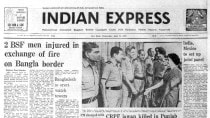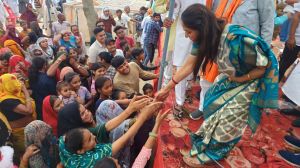- India
- International
Har Ghar Tiranga: The flag comes home
Anupam Hazra writes: The Har Ghar Tiranga campaign encourages Indians to take ownership of the tricolour.
 The 75th anniversary of Independence is the opportune occasion to commemorate the great journey of India and its people. It is also an opportunity to renew our pledge of patriotism. (Express Photo by Amit Mehra)
The 75th anniversary of Independence is the opportune occasion to commemorate the great journey of India and its people. It is also an opportunity to renew our pledge of patriotism. (Express Photo by Amit Mehra)More than seven decades ago, when India began its journey as a newly-born democracy based on universal adult suffrage, naysayers predicted its premature demise. A country of people distinguished more by their differences than commonalities had a lot going against it. To the Western theorists, India lacked the common thread that would weave the disparate and mostly illiterate population into a democratic nation. Such observations emanated from the European nations’ tryst with nationalism, an experience shaped primarily by the idea of common origin, language or religion. India had nothing in common; its birth was preceded by unprecedented bloodshed and religious animosity, a fact that further befuddled theorists and political scientists. However, India has not only survived the initial forebodings but also thrived as a vibrant and stable democratic nation, while its neighbours have floundered notwithstanding their shared commonalities. One may wonder how India has managed to achieve the incredible feat.
Though there is no single answer to this question, I believe there is something distinctly Indian — about the land and its people — that defies any explanation. For a land that believes and practises the philosophy of “vasudhaiva kutumbakam”, a land that whole-heartedly welcomed people from different parts of the world for centuries, embracing people of different origins, languages, religions and cultures is not a difficult task. However, the one thing that undoubtedly made India what it is today is the people of this great nation — their resilience, their aspirations and their unconditional love for the country.
The 75th anniversary of Independence is the opportune occasion to commemorate the great journey of India and its people. It is also an opportunity to renew our pledge of patriotism. A host of initiatives have been undertaken to celebrate the Azadi Ka Amrit Mahotsav and one among them is the Har Ghar Tiranga campaign. Every Indian is encouraged to hoist the tricolour at their home from August 13-15 to mark 75 years of independence.
The event has significance beyond the immediate excitement it has generated. A nation is primarily made of its people, who do not know each other personally. Yet they find that they are connected through an invisible sense of familiarity in the face of all the visible dissimilarities. The invisible and abstract familiarity or connectedness takes a concrete form in national symbols and the national anthem. The foremost among these symbols is the national flag.
The national flag covers all the lines that separate one from the other and holds all Indians together. Our relationship with the tricolour, however, has mostly been formal or institutional. Every year, flags are ceremoniously hoisted on Independence Day and Republic Day. Independence Day celebrations so far lacked a personal touch and engagement. Har Ghar Tiranga is aimed to redefine our relationship with our flag, and, in effect, with our nation and its past.

During British rule, the dream of raising our own flag on our soil inspired people. We have come a long way since then. However, for today’s fast-paced society, an event that took place more than seven decades ago may appear to be a thing of antiquity. Today, young people may find Gandhiji, Netaji Subhas Chandra Bose or Bhagat Singh as characters of a distant past cloistered in history books. If they do so, it is not their fault. We are at fault, as we failed to narrate the story of how India won the battle against the mightiest colonial power with non-violence and set a precedent for others to emulate. We must ensure that the people of India, especially the young minds, learn about the glorious past to feel proud of their nation.
Har Ghar Tiranga is aimed to achieve this larger goal. The government plans to take the campaign to virtually every home. The amendment of the Flag Code has paved the way for turning the excitement of the Har Ghar Tiranga campaign into a mass movement. Now, we can rightfully place our claim on our national flag. In this process, we would not only be remembering the contribution of Patel and Ambedkar to nation-building but also developing a curiosity about Pingali Venkayya.
The writer is a former MP and National Secretary, BJP
EXPRESS OPINION
More Explained
Apr 25: Latest News
- 01
- 02
- 03
- 04
- 05










































